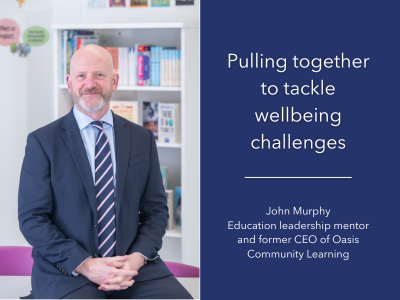With teachers struggling with their wellbeing John Murphy, education leadership mentor and former CEO of Oasis Community Learning, considers what schools can do to help.
Edurio’s recent report, Staff Wellbeing in Academies, deepened our understanding of the wellbeing pressures faced by the professionals working in our schools.
More than 11,000 teachers, leaders, administrators, teaching assistants and maintenance staff across England were surveyed about their wellbeing in the current academic year.
The report focused on six measures – overall wellbeing, quality of sleep, stress, overwork, getting support with mental and emotional wellbeing, and how excited they felt about their work. Teachers scored the lowest in five of these measures but were, encouragingly, still highly motivated and excited by their roles.
The aftermath of covid left a trail of ill health as well as anxiety about health. This factor, coupled with the pressures of the accountability system, is undoubtedly part of this complex picture. It would be easy to become despondent at these findings so it’s important to explore what we can learn. The first thing is to determine what schools with good wellbeing look like, and how we can ensure a good standard of wellbeing for teachers and other professionals working in all our schools.
The most important feature of a school with good wellbeing is that it has leaders who genuinely care for their staff – and role models that care all the time. Talking about it isn’t enough; positive relationships come first and those leaders who promote that culture demonstrate it daily. In cultures like this, if for example a teacher needs time off to go and see their own child’s end of term play, they’re not fearful of making what is a reasonable request. Leaders who actively listen and demonstrate these small acts of kindness set the ‘positive’ weather.
Really simple systems, coupled with great communication, promote staff wellbeing. Leaders in these schools let their staff know what is going to happen, why it is going to happen, when it’s going to happen and how it’s going to happen so staff aren’t fearful or overworked. Rather than creating initiative after initiative, these leaders promote a culture, and an understanding of how great schools operate.
Creating a culture of citizenship and accountability amongst all staff is just as vital. This is down to the leadership team as well as teachers. The basic principle is if everybody steps up and plays their part, everybody’s job becomes easier. A practical and simple example can be found during transitions between classes. If everybody in their classroom comes out and oversees the children down the corridor and plays an active role then that transition works far more effectively than if one teacher comes out and attempts the task alone. This ‘all in it together’ approach helps to foster happy and sustainable school environments.
Perhaps one of the most significant impacts on staff wellbeing is when leaders have the courage to ensure their school or group of schools harness a consistent curriculum offer and ensure that there is a robust and well sequenced curriculum for all students. This ensures the very best offer for all students and ensures that all staff have the agency to contribute to and benefit from the offer. This approach saves teachers 1000s of hours of planning and they benefit from the collective wisdom of all. Equally, the learning and development offer can be efficiently and effectively targeted to ensure great pedagogical delivery in the classroom. The education world should no longer be dominated by the mantra that “our children are very different to the school down the road”. We should act as a profession, not islands, and be constantly open to the best evidenced based approaches.
Government, of course, has an important role to play. It needs to step up when it comes to funding, resources and teacher supply, but in most other areas it should avoid intervention and let the profession be professional and work things out for itself. Giving education professionals that genuine freedom to determine their future would make a big contribution to overall wellbeing throughout the education sector. Government doesn’t tell surgeons how to go about their work in the operating theatre and the same principle should apply to schools. The work of the Chartered College and the National Institute of Teaching, which I helped to found, are big drivers and shapers of that culture of professional self-determination and they need to be given proper space for innovation and manoeuvre in the future.
Ultimately, experience suggests that consistent, caring and compassionate leadership, combined with high quality teacher training and development based on research, can make the biggest difference to the health and happiness of teachers. If teachers feel enabled, well-inducted, well trained, well supported – and well paid, of course – they will be in the best position to deliver the highest quality education for our children and young people.
Edurio’s Wellbeing in Academies report is available here
